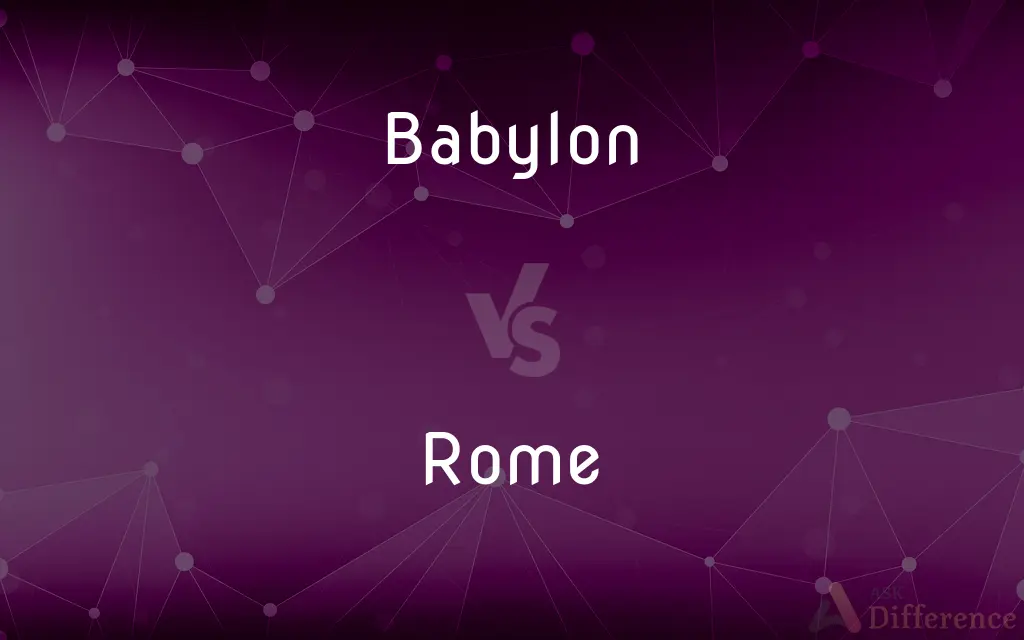Babylon vs. Rome — What's the Difference?
By Tayyaba Rehman & Maham Liaqat — Updated on May 1, 2024
Babylon was a key Mesopotamian city, known for its Hanging Gardens, while Rome, the heart of the Roman Empire, is famed for its extensive legal and political influence.

Difference Between Babylon and Rome
Table of Contents
ADVERTISEMENT
Key Differences
Babylon, located along the Euphrates River, was a major city in ancient Mesopotamia and is often associated with its grand architectural achievements and mythical Hanging Gardens. Whereas, Rome, situated on the Tiber River, became the center of the Roman Empire, which significantly shaped Western culture and governance.
Babylon reached its zenith under the rule of Nebuchadnezzar II in the 6th century BCE, known for its impressive walls and the Ishtar Gate. On the other hand, Rome saw its peak during the Imperial period, under leaders like Augustus and Trajan, marked by monumental structures like the Colosseum and extensive road networks.
The society in Babylon was heavily influenced by the Code of Hammurabi, one of the earliest and most complete written legal codes, which laid the groundwork for the justice system. In contrast, Rome developed the Roman Law, the foundation of the legal systems in many Western countries, demonstrating a more structured approach to governance and law.
Religiously, Babylon was a polytheistic society with gods like Marduk and Tiamat, centered around temple complexes such as the Esagila. Conversely, Rome initially practiced a polytheistic religion influenced by the Greek pantheon and later became the heartland of Christianity, drastically altering its cultural and social landscape.
The decline of Babylon was marked by its conquest by the Persians in 539 BCE, leading to a loss of its political sovereignty and gradual decline. Rome, however, transitioned from a republic to an empire and eventually split into Eastern and Western entities, facing its decline through prolonged conflicts and internal decay over centuries.
ADVERTISEMENT
Comparison Chart
Location
Mesopotamia, near the Euphrates
Italian Peninsula, near the Tiber
Peak Period
6th century BCE
1st–2nd century CE
Government
City-state, kingdom
Republic, then Empire
Cultural Influence
Mesopotamian
Greco-Roman
Legal Contributions
Code of Hammurabi
Roman Law
Compare with Definitions
Babylon
An ancient city in Mesopotamia, known for its architectural wonders.
The ruins of Babylon still capture the imagination of historians and tourists alike.
Rome
The capital city of Italy, historically significant as the center of the Roman Empire.
Rome today is a blend of ancient relics and modern life.
Babylon
In biblical contexts, often depicted as a place of exile.
Babylon is frequently mentioned in the Bible, particularly in the contexts of captivity and prophecy.
Rome
Often used metaphorically to represent power and control.
The phrase all roads lead to Rome symbolizes centralized power.
Babylon
A cultural epicenter of ancient times.
Babylon was a melting pot of ancient cultures and innovations.
Rome
In historical contexts, refers to the Roman Republic or Empire.
Rome was once the most powerful city in the ancient world.
Babylon
Symbolically, represents opulence and decadence.
Some modern cities are likened to Babylon because of their luxurious lifestyles.
Rome
A symbol of cultural and architectural achievement.
Rome’s ancient monuments still stand as testaments to its architectural prowess.
Babylon
Represents the rise and fall of great civilizations.
Like many great empires, Babylon experienced both peak and decline in its history.
Rome
Represents legal and political innovation.
Rome’s contributions to law and governance continue to influence the modern world.
Babylon
Babylon was the capital city of the ancient Babylonian Empire, which itself is a term referring to either of two separate empires in the Mesopotamian area in antiquity. These two empires achieved regional dominance between the 19th and 15th centuries BC, and again between the 7th and 6th centuries BC. The city, built along both banks of the Euphrates river, had steep embankments to contain the river's seasonal floods.
Rome
Rome (Italian and Latin: Roma [ˈroːma] (listen)) is the capital city and a special comune of Italy (named Comune di Roma Capitale), as well as the capital of the Lazio region. The city has been a major human settlement for almost three millennia.
Babylon
A city or place of great luxury, sensuality, and often vice and corruption.
Rome
The capital of Italy and of the Lazio region, situated on the River Tiber about 25 km (16 miles) inland; population 2,724,347 (2008).
Babylon
A place of captivity or exile.
Rome
A variety of apple having round firm fruit with tough red skin.
Babylon
A female breast.
Rome
Capital and largest city of Italy; on the Tiber; seat of the Roman Catholic Church; formerly the capital of the Roman Republic and the Roman Empire
Babylon
The chief city of ancient Mesopotamia and capitol of the ancient kingdom of Babylonia
Rome
The leadership of the Roman Catholic Church
Common Curiosities
What legal contributions did Rome make?
Rome introduced Roman Law, which has significantly influenced the legal systems of many Western countries.
How did the religions of Babylon and Rome differ?
Babylon practiced polytheism with a pantheon of Mesopotamian gods, while Rome’s religion evolved from polytheism to Christianity.
What led to the decline of Babylon?
Babylon declined after being conquered by the Persians and losing its political sovereignty.
What is the significance of the Code of Hammurabi?
It is one of the oldest deciphered writings of significant length and set the foundation for future legal codes.
How did Babylon influence modern cultures?
Babylon's cultural and scientific achievements, particularly in astronomy and mathematics, have left a lasting legacy.
What was the role of religion in the Roman Empire?
Religion in Rome was integral to social and political life, influencing everything from governance to daily routines.
How did Rome's political system evolve?
Rome evolved from a monarchy to a republic and then to an imperial system under the control of emperors.
How did the geographic location affect Babylon?
Located by the Euphrates, Babylon was well-situated for trade and agriculture, aiding its economic prosperity.
What impact did Roman architecture have?
Roman architectural innovations include the development of the arch, dome, and concrete, which have had lasting impacts on construction.
What are some surviving relics of Roman civilization?
Major relics include the Colosseum, Roman Forum, and the Pantheon.
What are the key achievements of Babylon?
Babylon is famed for its architectural achievements including the Hanging Gardens and the Ishtar Gate.
How did the Roman Empire manage its vast territories?
The Roman Empire managed its territories through a complex road network and a well-organized administrative structure.
How has Rome influenced modern legal systems?
Many legal principles originating in Roman Law, like the rights of individuals and property laws, are foundational to modern Western legal systems.
Who were some notable rulers of Babylon?
Nebuchadnezzar II is notably one of Babylon's most famous rulers.
What are the literary references to Babylon in modern times?
Babylon often appears as a symbol of decadence and corruption in literature and popular culture.
Share Your Discovery

Previous Comparison
Telmisartan vs. Candesartan
Next Comparison
Biomechanics vs. KinesiologyAuthor Spotlight
Written by
Tayyaba RehmanTayyaba Rehman is a distinguished writer, currently serving as a primary contributor to askdifference.com. As a researcher in semantics and etymology, Tayyaba's passion for the complexity of languages and their distinctions has found a perfect home on the platform. Tayyaba delves into the intricacies of language, distinguishing between commonly confused words and phrases, thereby providing clarity for readers worldwide.
Co-written by
Maham Liaqat















































